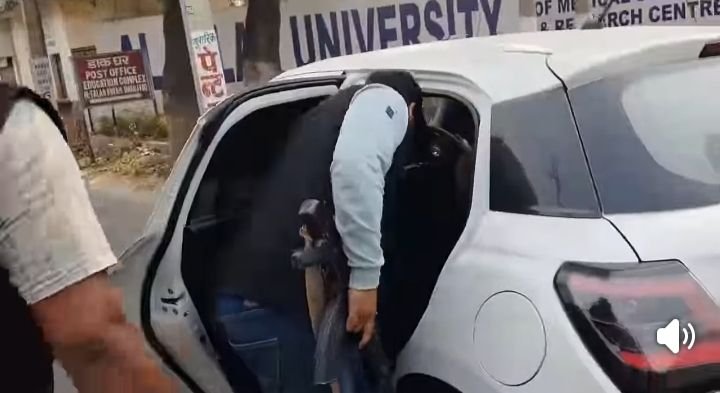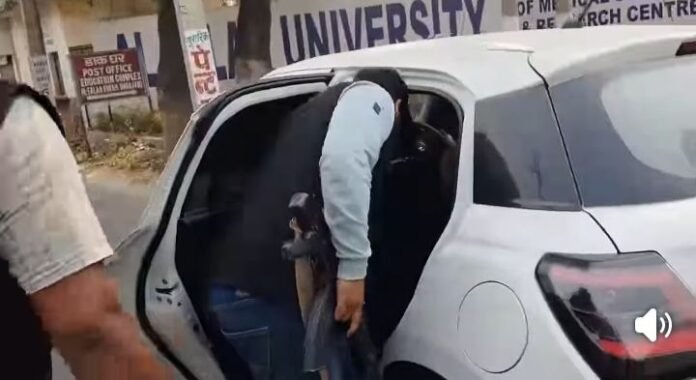Terror Pitch in Haryana: How Faridabad Became a Breeding Ground for Extremists
In the heart of Haryana’s Faridabad district, a grim truth has now come into sharp focus: a terror network was operating under the radar, aided by an educational institution, and laying the groundwork for possibly a catastrophic attack in the National Capital Region. The drama involving the car-blast near Delhi’s Red Fort on November 10 is now tightly linked with the arrest of three doctors and the seizure of almost 2,900 kg of explosives in Faridabad — and with it comes serious questions about the state’s police intelligence, the functioning of its law-enforcement machinery and the alleged political overshadowing of crime-control in Haryana.
The Scene Unfolds: How Faridabad Turned Into a Safe Haven
The story begins with the explosion in Delhi: a car blasted near the Red Fort, killing more than a dozen people and hurting dozens more.
Investigators quickly traced links to a terror cell operating out of Haryana. In Faridabad’s Dhauj village and in nearby rented flats, police uncovered massive quantities of ammonium-nitrate and other IED-making gear.
A key institution in this web is Al‑Falah University — a private campus near Faridabad, whose faculty and alumni are now under intense scrutiny. At least one doctor attached to the university has been arrested for his alleged role in the terror module. The disturbing allegation: an academic institution is being used as a front for radicalised professionals and students to receive direction, funds and infrastructure for terror. As one investigative piece put it, a “white-collar terror ecosystem” appears to have taken root.
For Haryana, this is a wake-up call. Its proximity to Delhi, the open transit routes, porous jurisdictional boundaries and the relative ease of movement between states make it attractive to terror modules seeking to hide in plain sight. A former DGP warned recent events expose “the state emerging as a safe haven for terror operatives.”
Where Has Police Intelligence Failed?
The debacle raises tough questions about how the Haryana Police conducts its counter-terror intelligence and crime-monitoring processes:
• Delayed detection: A vast cache of explosives and arms was amassed far too long before law enforcement intervened. The module had sufficient materials to cause large-scale devastation.
• Weak coordination: The state police had to work in synch with Jammu & Kashmir Police, suggesting local intelligence and leads were weak until picked up externally.
• Focus diverted: Analysts point to the fact that Haryana Police appears more adept at social-media PR and high-visibility activity rather than deep undercover work, surveillance and intelligence along interstate corridors.
• Local complacency: The notion that “terror doesn’t happen here” appears to have influenced strategy, leaving the state vulnerable to sleeper cells and courier networks.
Why Terror Networks Target Haryana
Why did this module pick Faridabad and surrounding areas? Some reasons stand out:
• Transit advantage: Faridabad sits on major corridors and provides direct access to Delhi and the NCR regions. That makes it ideal for moving illicit material and personnel.
• Institutional cover: Using a private university as a façade makes detection harder. Academic credentials, international collaboration, medical and engineering labs provide plausible cover.
• Radicalised professionals: The fact that doctors and educated individuals were involved is deeply troubling. These modules don’t rely only on disenfranchised elements — they draw from respectable professions, making surveillance and suspicion harder.
• Cross-border funding & ideology: Investigations show suspected links to Pakistan-based outfits such as Jaish‑e‑Mohammed (JeM) and Ansar Ghazwat ul Hind (AGuH). The network exploited academic, charitable and social channels.
The Political and Policing Paradox in Haryana
Here lies a deeper malaise. On one hand, Haryana’s police machinery is tough and swift when dealing with common citizens — protests, political opponents, local crime often meet stringent action. On the other hand, when it comes to serious crime involving terror modules, you see hesitation, delay and reactive moves instead of proactive strategy.
• Harsh on dissent, soft on terror? Several critics argue that the police’s heavy-handed approach to political dissent contrasts sharply with its laxity when confronting organised terror.
• Blame-game after the fact: By the time action is taken, the network has already embedded itself. Offenders often escape, while investigations begin late and rush to cover tracks.
• Political will gap: While crime figures and terror threats are publicly acknowledged, the machinery rarely receives the consistent high-priority leadership attention that smaller political controversies do.
• People-friendly policing missing: For citizens to trust anti-terror efforts, policing must be visible, approachable, transparent and community-connected. Often, Haryana’s intelligence interface lacks this local engagement.
How Things Must Change
To ensure such a situation does not repeat, Haryana must recalibrate both its strategy and execution:
1. Strengthen intelligence architecture: Build a permanent counter-terror intelligence desk that shares data with central agencies, monitors academia and monitors cross-border fund flows.
2. Modern surveillance of inter-state corridors: Entry-exit points, interstate transit routes, rental accommodations near institutions must be under watch. The Faridabad-Dhauj case shows how easily materials were stored in rented flats.
3. Institutional vigilance: Education and professional institutions need oversight to prevent misuse as radicalisation centres. Need for background checks, monitoring of trust funds, foreign donations under strict lens.
4. Community-centric policing: Instead of only reacting, police should proactively engage with locals, students, faculty and professionals so early red-flags can be identified.
5. Political alignment & accountability: Local leadership must place internal security on an equal footing with other issues. Political messaging must emphasise public safety over optics and dissent-management.
6. Transparent after-action reviews: Each major seizure or bust must trigger public review of intelligence failures, so mistakes become lessons, not cover-ups.
Conclusion: Haryana at Crossroads
What happened in Faridabad serves as a sobering reminder: Terror is no longer the distant mountain hide-out – it is sneaking into urban campuses, rented flats, transit corridors and professional networks. That Haryana, with its booming economy and proximity to Delhi, should become a soft target is alarming but not surprising, given the features exploited by this cell.
For the people of Haryana to feel safe, for the state to reclaim its image as secure, the policing machinery must evolve. Tough streets and hard crackdowns are not enough. What’s needed is smart, community-connected, intelligence-driven, people-friendly policing — and crucially, the political will to prioritise this reform. The question is: will the leadership and the system act now before the next module strikes?






